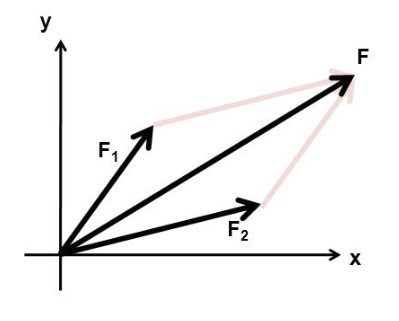Sum of the two vectors - the result

Sum of vectors (size, magnitude) F = F1 + F2 = 1053.4181625282
Directional angle of the resulting vector φ = 30°50'21″ = 30.839276373726° = 0.1713293 rad
How to add two vectors
If we place the vectors at one starting point, the vectors form two sides of the parallelogram. By completing the remaining two parallel sides, we create a parallelogram. The resulting vector of the sum is the oriented diagonal of this parallelogram starting at the location point of the vectors.Analytically - by calculation, we calculate the sum of vectors most simply by dividing the vectors into x, y, or z components. We then add the individual vectors by components. We then calculate the size of the resulting vector from the Pythagorean theorem from its component form. We determine the direction vector trigonomically - by the arctangent of the y:x ratio.
Vectors in word problems
- Vector
 Determine coordinates of the vector u=CD if C[12;-8], D[6,20].
Determine coordinates of the vector u=CD if C[12;-8], D[6,20]. - Vector - basic operations
 There are given points A [-9; -2] B [2; 16] C [16; -2] and D [12; 18] a. Determine the coordinates of the vectors u=AB v=CD s=DB b. Calculate the sum of the vectors u + v c. Calculate the difference of vectors u-v d. Determine the coordinates of the vecto
There are given points A [-9; -2] B [2; 16] C [16; -2] and D [12; 18] a. Determine the coordinates of the vectors u=AB v=CD s=DB b. Calculate the sum of the vectors u + v c. Calculate the difference of vectors u-v d. Determine the coordinates of the vecto - Coordinates of vector
 Determine the coordinate of a vector u=CD if C(19;-7) and D(-16;-5)
Determine the coordinate of a vector u=CD if C(19;-7) and D(-16;-5) - Place vector
 Place the vector AB if A (3, -1), B (5,3) in point C (1,3) so that AB = CO.
Place the vector AB if A (3, -1), B (5,3) in point C (1,3) so that AB = CO. - Line
 Line p passes through A[5, -3] and has a direction vector v=(2, 3). Is point B[3, -6] on the line p?
Line p passes through A[5, -3] and has a direction vector v=(2, 3). Is point B[3, -6] on the line p? - Distance of the parallels
 Find the distance of the parallels, which equations are: x = 3-4t, y = 2 + t and x = -4t, y = 1 + t (instructions: select a point on one line and find its distance from the other line)
Find the distance of the parallels, which equations are: x = 3-4t, y = 2 + t and x = -4t, y = 1 + t (instructions: select a point on one line and find its distance from the other line) - Points collinear
 Show that the point A(-1,3), B(3,2), C(11,0) are col-linear.
Show that the point A(-1,3), B(3,2), C(11,0) are col-linear.
- Direction 7999
 A (5; -4) B (1; 3) C (-2; 0) D (6; 2) Calculate the direction vector a) a = AB b) b = BC c) c = CD
A (5; -4) B (1; 3) C (-2; 0) D (6; 2) Calculate the direction vector a) a = AB b) b = BC c) c = CD - Perpendicular lines
 Points A(1,2), B(4,-2) and C(3,-2) are given. Find the parametric equations of the line that: a) It passes through point C and is parallel to the line AB, b) It passes through point C and is perpendicular to line AB.
Points A(1,2), B(4,-2) and C(3,-2) are given. Find the parametric equations of the line that: a) It passes through point C and is parallel to the line AB, b) It passes through point C and is perpendicular to line AB. - Linear independence
 Determine if vectors u=(-4; -10) and v=(-2; -7) are linear dependents.
Determine if vectors u=(-4; -10) and v=(-2; -7) are linear dependents. - Parametric equations
 Write the parametric equations of height hc in triangle ABC: A = [5; 6], B = [- 2; 4], C = [6; -1]
Write the parametric equations of height hc in triangle ABC: A = [5; 6], B = [- 2; 4], C = [6; -1] - Coordinates of a centroind
 Let A = [3, 2, 0], B = [1, -2, 4], and C = [1, 1, 1] be 3 points in space. Calculate the coordinates of the centroid of △ABC (the intersection of the medians).
Let A = [3, 2, 0], B = [1, -2, 4], and C = [1, 1, 1] be 3 points in space. Calculate the coordinates of the centroid of △ABC (the intersection of the medians). - Vector equation
 Let's v = (1, 2, 1), u = (0, -1, 3) and w = (1, 0, 7). Solve the vector equation c1 v + c2 u + c3 w = 0 for variables c1, c2, c3 and decide whether v, u, and w are linear dependent or independent
Let's v = (1, 2, 1), u = (0, -1, 3) and w = (1, 0, 7). Solve the vector equation c1 v + c2 u + c3 w = 0 for variables c1, c2, c3 and decide whether v, u, and w are linear dependent or independent - Vector perpendicular
 Find the vector a = (2, y, z) so that a⊥ b and a ⊥ c where b = (-1, 4, 2) and c = (3, -3, -1)
Find the vector a = (2, y, z) so that a⊥ b and a ⊥ c where b = (-1, 4, 2) and c = (3, -3, -1) - Vector v4
 Find the vector v4 perpendicular to the vectors v1 = (1, 1, 1, -1), v2 = (1, 1, -1, 1) and v3 = (0, 0, 1, 1)
Find the vector v4 perpendicular to the vectors v1 = (1, 1, 1, -1), v2 = (1, 1, -1, 1) and v3 = (0, 0, 1, 1)
more math problems »
